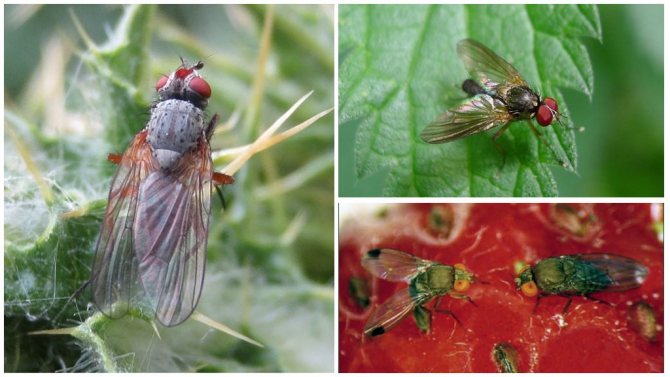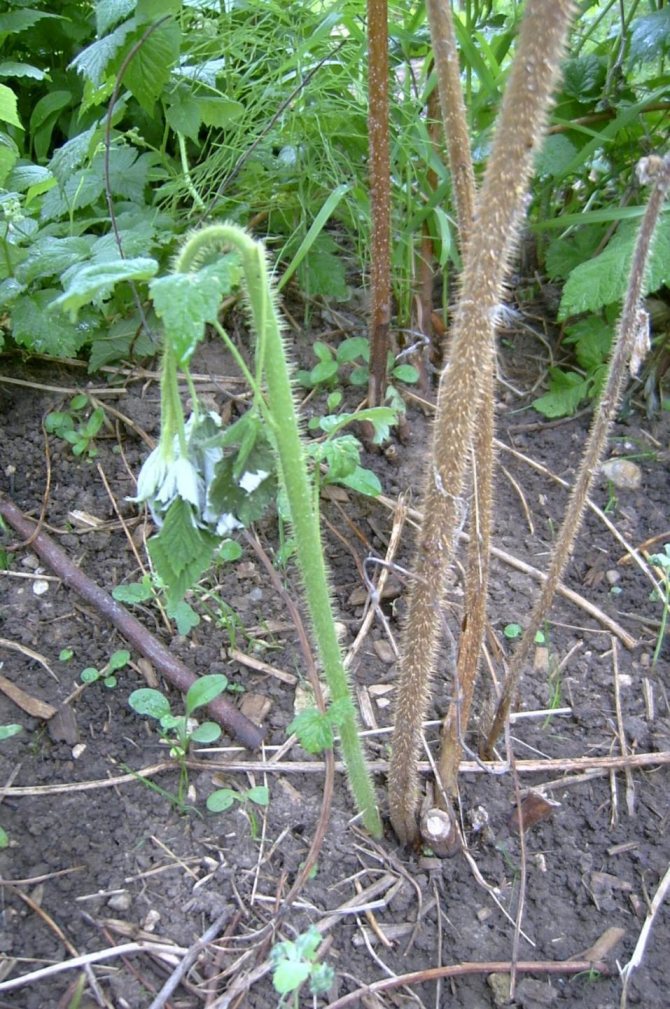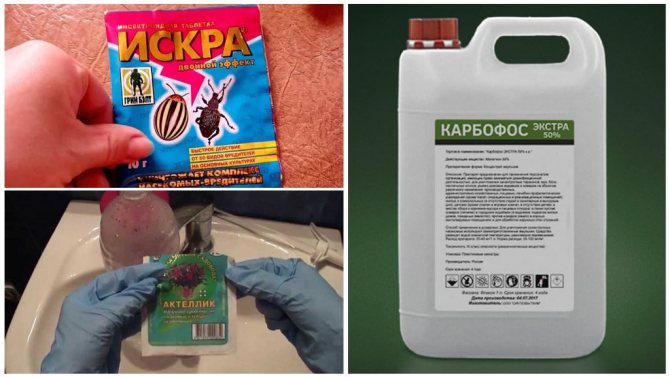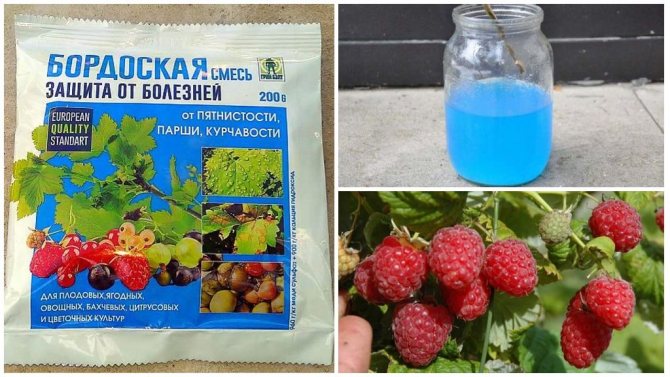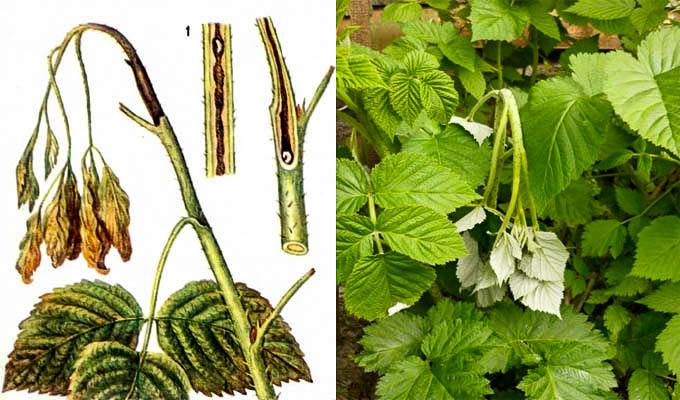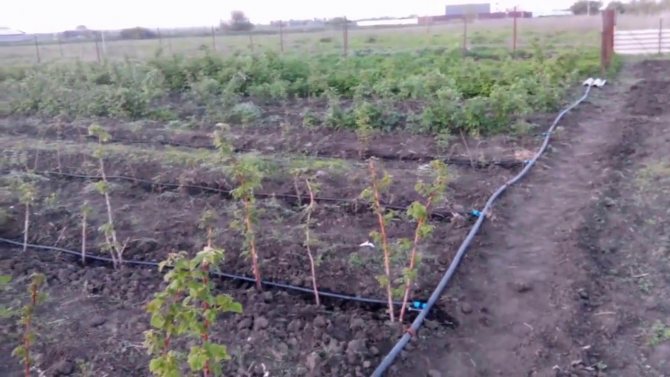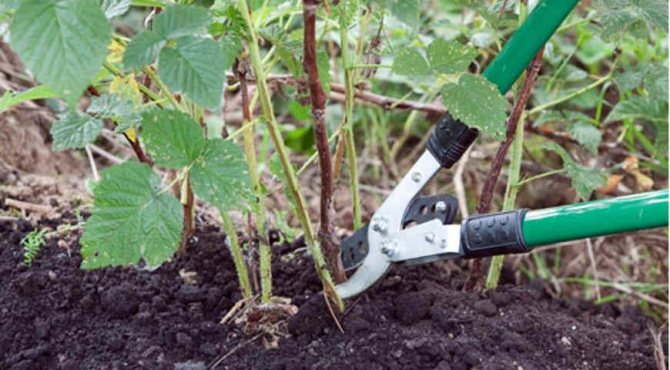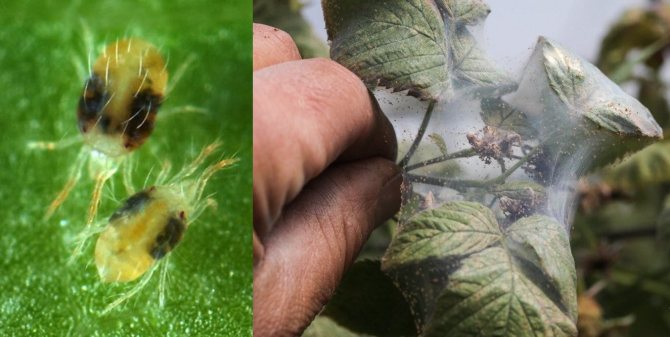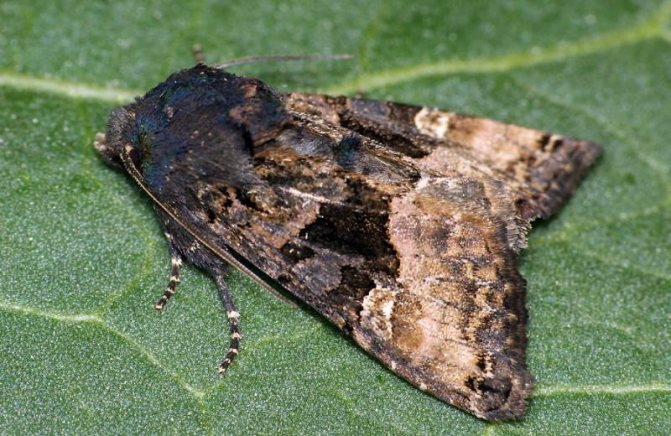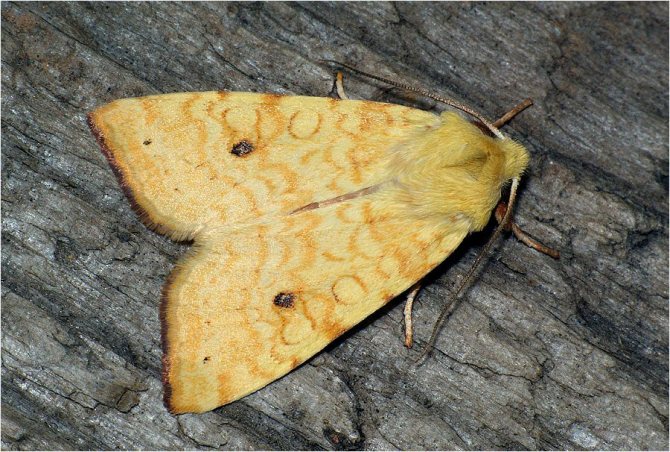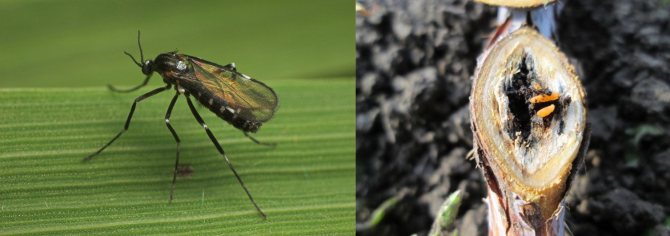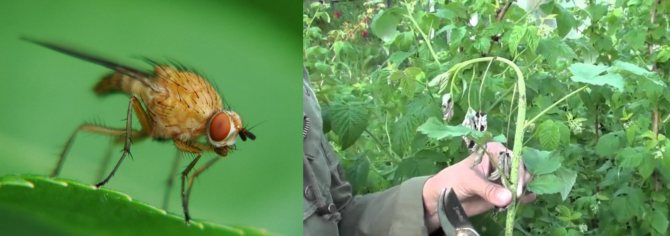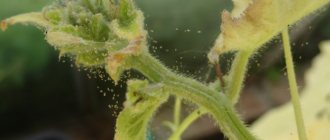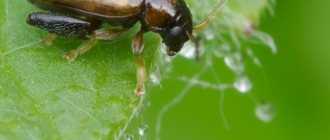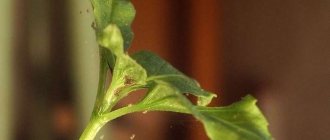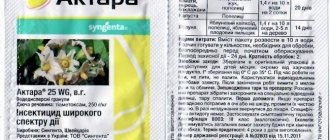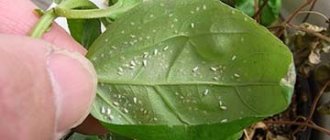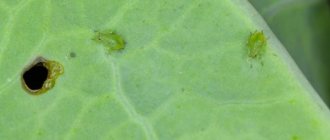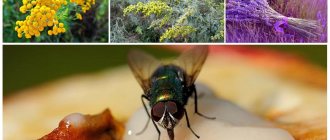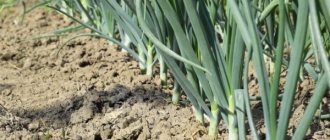Flies of various types cause a lot of trouble for gardeners and truck farmers. The danger to raspberries is the so-called raspberry fly. If it appears on the bushes, the owners of home gardens may be left without most of the tasty and healthy berries. Therefore, the fight against the raspberry fly must be carried out without fail. There are different ways that you can help get rid of pests. Before you learn about them, you need to find out what these insects look like.
What is the harm from a raspberry fly
The fly itself does not bring much harm to the shoots, but the larvae laid by it pose a great danger to the plant. It strikes the very first, strongest shoots. A raspberry stem fly pierces a young stem at the top of it and lays eggs there. A puncture is sometimes difficult to see, it is quite small, but looking closer you can see a hole, and around an unhealthy dark fabric.
After 5-8 days, larvae develop from the eggs, small white oval worms up to 2-3 mm in size. The larva begins to move down the stem, eating up the middle of the stem. Naturally, the nutrition of the tops is disrupted. First, the leaves hang on the shoot, wither, and later the shoot dries up and dies. If you break the stalk, then there you can see a larva - a worm, as in this photo.
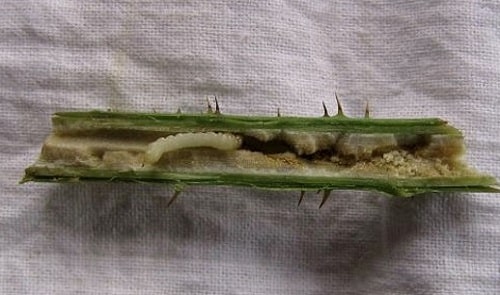
The larvae spend the winter in the upper layers of the soil, where they pupate, and with the onset of warmth in early spring, a new generation of flies crawls out of the ground. One fly can lay up to 90 eggs per season.
Description of the pest
The raspberry stem fly is a small brown-gray insect, no more than 0.7 cm in length. It spends winter in the upper layers of the soil, right under the raspberry bushes.
The timing of when the insect activates depends on the climatic conditions of the region. In the Caucasus, this is April, in the Moscow region, the beginning of May, in the Urals even later. During this period, raspberries actively give young shoots, which the fly uses for laying eggs.
Stem fly females are very fertile and can lay up to nine dozen microscopic eggs in the axils of raspberry leaves.


Control measures
In the fight against flies, chemical, biological and folk remedies are used.
Insecticides
Chemicals are used both for prophylactic purposes and for controlling the fly. It is important to remember that insecticide treatment is carried out in calm weather, preferably in the morning or evening, when the sun is not high. Processing can be carried out during the day, but in cloudy weather. Such restrictions are necessary so that after processing, sunburn does not form on the fragile leaves. Of course, such preparations should not be used before the rain.
Working solutions of these products are used to treat leaves and stems from flies and the soil under bushes to destroy the larvae.
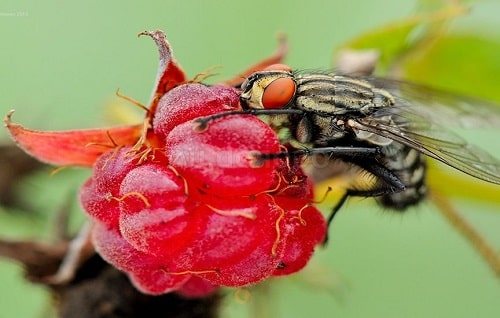

For processing, you can use the following tools:
- Karbofos - moderately toxic drug, for use 60 g of the product is diluted in 1 bucket of water. It is necessary to be careful if there are hives nearby, since the drug has a detrimental effect on bees;
- Spark - a drug with a wide spectrum of action, including against the raspberry fly. 1 tablet of the product is diluted in 10 liters of water;
- Atellik - sold in ampoules of 2 ml and in cans of 5 liters.Before diluting the product, you must follow the instructions for use. Due to the strong toxicity of the drug, it can be used no more than two times per season;
- Contifor - a highly effective, low-toxic agent, during processing seeps through the surface of leaves, stems, roots. Protects the plant from flies for two weeks, so repeated treatments are required.
- Fufanon-nova - an effective systemic insecticide, The solution is induced according to the instructions, 1 ampoule is diluted with 5.5 liters of water.
All insecticides are poisonous, therefore, when working with them, you must be careful, wear protective clothing, glasses, gloves.
Biological preparations
- Fitoverm - the drug acts on a large number of flying insects. The action occurs when the drug has entered the gastrointestinal tract of an insect, and does not affect the larvae and pupae, since they do not feed. This remedy is safe for bees. The drug is bred according to the instructions, the leaves and crown of bushes and trees are treated. After guidance, the solution must be used immediately. Harvesting can be carried out no earlier than 2 days later.
- Agravertine - alcohol extract of streptomyces soil fungus. Getting into the gastrointestinal tract of the insect after 12 hours, the drug begins to act, paralyzing the insect and causing its death after 3 days. The solution is guided according to the instructions and used immediately after it is guided. The drug is especially effective in hot weather.
Folk methods of struggle: Bordeaux liquid
The specificity of the pest is such that compositions that are effective in relation to other insects for spraying their own preparation do not affect the raspberry fly. However, gardeners are constantly looking for their own ways to get rid of this insidious enemy. For example, Oksana Koklyushkina, in a commentary to an article on fighting a sawfly on a gooseberry, shares her way of dealing with a raspberry stem fly. She claims that it is enough to shed the soil with Bordeaux liquid in the fall and there will be no pest problems on raspberry bushes, and there will be no gooseberry ones either.


Composition for the preparation of Bordeaux liquid
From our point of view, there is a positive meaning in the use of this substance, however, simply pouring a liquid solution on the soil is clearly not enough in our opinion. Most likely, the reader uses some kind of insecticidal preparation for spraying, and additionally processes the soil with the aforementioned agent.
As a reference. Bordeaux liquid is a mixture of copper sulfate (better known as copper sulfate) with milk of lime. In gardening, this drug has been used for a very long time, but primarily in the fight against diseases of trees, shrubs, grapes, roses. Its effectiveness has been proven in the elimination of fruit rot, rust, scab, stem cancer, gray rot, septorizosis, cocomycosis, etc. Bordeaux liquid can also be used against pests, only before flowering at the stage of budding.
If you have anything to add to the recommendations on how to get rid of the raspberry stem fly, write in the comments to the article. We will be glad to have a lively dialogue and exchange of views. There are criticisms - leave them as well. Any opinion of our readers is important to us, because the idea of creating a blog is to collect useful information about a particular pest and how to deal with it.
Check out articles on similar topics
- Proven measures to control raspberry-strawberry weevil
- How to get rid of a raspberry beetle
- What to do if cabbage has attacked raspberries
- Raspberry spider mite treatment
Comments (1)
leave a comment
Folk remedies and care for the raspberry tree
Correct and timely care of the raspberry tree will not give the opportunity to lay the larvae in the stems and will make it impossible for the larvae to develop in the soil. What is raspberry care?
- As soon as the first shoots begin to appear, inspect the raspberry tree once a week. Seeing withered young shoots, you must immediately cut them out and be sure to burn them. Cut the stem at ground level and even burrowing a little into the ground;
- To scare off flies, the bushes are irrigated with a solution of baking soda (2 tablespoons per bucket of water) and irrigated before the berries begin to set. For this purpose, someone sprays the bushes with a solution of mustard, which also helps;
- To prevent the raspberry fly from laying eggs, it is necessary that adults do not hatch from the larvae in the spring. For this purpose, mulching is carried out with a layer of at least 8 cm. Plant residues, peat, sawdust are used as mulch;
- Remove old branches and young weak growth in a timely manner. They take on useful substances, the return on them will be minimal. The remaining young stems will take up more nutrients, grow stronger faster and better cope with pests and diseases. In addition, thickened raspberries are an ideal environment for flies;
- Treat the raspberry plant in advance with biological preparations, they are harmless and effective, they act on other pests, but they are safe for bees;
- In the fall, after harvesting, collect the screeching foliage, loosen the soil under the bushes, in the loose earth the pupae will freeze faster in winter. Loosen the soil carefully so as not to damage the root system. You can treat the soil with some kind of insecticide.
Do not forget to feed the bushes in the spring, then in the summer they will delight you with an abundant harvest of sweet berries.
Here you can order the most fruitful varieties of raspberries of the NGO "Sady Rossii"
How a stem fly gets into a raspberry tree
Some mistakes in agricultural technology can cause a pest to appear on the bushes:
- bad neighborhood - do not plant new raspberry bushes near blackberries, meadowsweet and meadowsweet. These plants are susceptible to attack by the raspberry stem fly. The same applies to the neighbor's raspberry tree - no fence will save you from the pest;
- raspberry thicket - do not run raspberry bushes. Prune bushes in time. It is important to dig up the soil well, but it is difficult to do this if the plantations have turned into a dense impenetrable forest;
- fly on honey - a raspberry stem fly can be attracted by aphids, more precisely - the honeydew it emits. If you do not fight with one pest, the appearance of another will not keep you waiting;
- bad fertilization - fly larvae can get in with infected humus when mulching the soil under the bushes.
Characteristic
As you can see in the photo, a raspberry or stem fly is a small insect with a pubescent body and a pair of transparent wings. The dimensions are insignificant - the body length of an adult does not exceed 7 mm. The larva is a worm-like caterpillar, with a pale, off-white body color, which is about 5 mm in size. The larva has no legs; the mouth apparatus is located between the two anterior body segments. The adult caterpillar encloses itself in a barrel-like false cocoon, which is brown in color. In this cocoon, parasites hibernate, usually in the upper layer of the soil.
In May, when the substrate in the zones of occurrence of the larvae warms up to + 12 ... 13 ° C, they pupate. Development in the pupa lasts about 7-9 days, after which adult flies emerge from them, whose years lasts from 8 to 10 days. In cold and rainy weather, the flight may take a little longer - up to 20 days. In such conditions, most pupae die. The sexually mature flies that have flown out are fed on flower nectar, dew and the sugar secretion of other insect pests, after which the females make clutches. They usually place eggs on the tops and in the axils of not yet formed leaves, young shoots and in the root processes of raspberries.
Fertility of raspberry stem fly females is 60-90 eggs.Development in the egg takes from 5 to 8 days, after which the larvae emerge from them. Young growth bites into the middle of young stems and makes spiral and ring-like passages. The apical parts of the damaged stems gradually fade, turn black and die off over time. After 12-16 days, feeding of the larvae stops. They gnaw through the stem and go down into the soil for the winter quarters along the passages made. There they entangle themselves with a false cocoon and remain until spring.
On a note! The number of raspberry stem flies is limited by many predatory insects, especially ground beetles!
Prophylaxis
As you can see, the raspberry fly is very dangerous, and the fight against it can take a long time. And in order to avoid trouble and prevent re-infection, it is necessary to act competently throughout the season. The quantity and quality of the harvested crop will depend on this.
Prevention is pretty simple:
- regularly inspect the bushes in your raspberry plant and pay special attention to the condition of young shoots;
- if you know that a raspberry fly has definitely started up in a neighboring area, then it will be useful to carry out preventive treatment with the drug "Karbofos" or "Actellik";
- dig up the site in spring and autumn and immediately collect all plant residues;
- before winter, it is advisable to spud all the bushes and fill the soil with compost or peat mulch around them.
Remember, if you follow all the precautions throughout the season, you can protect your raspberry tree from pest attacks. And even if the infection happened, do not give up, because now you know the methods of dealing with raspberry stem fly. They are efficient and easy to implement.
What to process
Processing is carried out both with chemical preparations (urea, copper sulfate, dolomite flour, Bordeaux liquid) and folk remedies (mustard, soda, boiling water, infusions of herbs and flowers).
To strengthen the plants, in early spring, they are treated with urea. 15-20 grams are taken per square meter. Urea saturates the bushes with nitrogen and makes them less susceptible to disease.
Processing raspberries with copper sulfate avoids the appearance of fungal diseases (gray rot, anthracnose). Raspberry stems and soil around the bushes are processed. For spraying, take 50 grams of vitriol per 5 liters of water.
During the growing season and during the active growth of the plant, treatment with copper sulfate cannot be performed. It accumulates in berries and stems.
In the fight against anthracnose, rust and powdery mildew, the treatment of bushes with a 1% solution of Bordeaux liquid or iron vitriol, Topaz, Nitrofen helps.
The main reasons for the development of infections are high humidity and high acidity of the soil. Reducing watering reduces moisture. Acidity can be reduced with wood ash, slaked lime, dolomite flour. 150 grams are taken per square meter.
Mustard protects raspberries from weevil larvae.
For spraying, take 20 grams of dry mustard per 10 liters of water, everything is mixed and infused for 12 hours. Spraying of bushes is done in several passes.
Instead of mustard, you can take baking soda, 2 tablespoons should be diluted in 10 liters of water.
Treatment of bushes and basal circle with boiling water allows you to get rid of most pests. The procedure is performed after the snow melts and the soil warms up.
With a small area of damage, the larva of the raspberry beetle can be harvested by hand. Before flowering, processing is performed with an infusion of bitter wormwood and marigolds. When using Agravertine and Agravertine, processing is done twice.
During budding, raspberries can be sprayed with tansy infusion.
For the infusion, 350 grams of dry grass or a kilogram of freshly harvested raw materials, 5 liters of water are taken.Tansy is infused for a day, then boiled for half an hour, filtered and diluted with the same amount of water.
Pine needles mulching protects against weevils and gray mold.
Remember
- Start your fight against the raspberry fly in time, because it multiplies very quickly and weakens the plants. If you start the situation, it will become much more difficult to remove it from the site.
- Observe prophylaxis against flies, because it is much easier to prevent a disease than to cure it later.
- Take proper care of your raspberries, remember that pests most often attack weak plants.
- Use folk remedies whenever possible. they are much safer than purchased ones, do not accumulate in the soil and are cheaper.
- Observe safety measures when using chemicals: work with gloves and a respirator, after handling, wash your hands and face.

